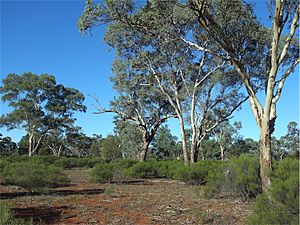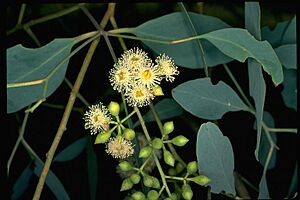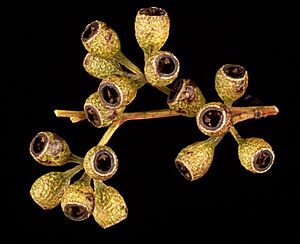Inland red box facts for kids
Quick facts for kids Inland red box |
|
|---|---|
 |
|
| Eucalyptus intertexta near Mount Hope | |
| Scientific classification | |
| Genus: |
Eucalyptus
|
| Species: |
intertexta
|
The Inland Red Box (scientific name: Eucalyptus intertexta) is a special type of tree found only in central Australia. People also call it the Western Red Box, Gum Coolibah, or Bastard Coolibah. This tree has rough, stringy bark near the bottom of its trunk. Higher up, its bark is smooth and can be white or brownish. It has long, narrow leaves, white flowers that grow in groups, and fruit shaped like a cup.
Contents
About the Inland Red Box Tree
The Inland Red Box is usually a tree, but sometimes it grows as a mallee. A mallee is a type of eucalyptus that has many stems growing from a large, woody base underground called a lignotuber. This tree can grow quite tall, from about 4 to 30 meters (13 to 98 feet) high.
Its bark is rough and stringy at the bottom of the trunk. Sometimes, this rough bark covers the whole trunk. Above the rough part, the bark is smooth and can be white, grey, or brownish.
Leaves and Flowers
Young Inland Red Box plants have dull, greyish leaves. These leaves are long and narrow, measuring about 3 to 12 centimeters (1.2 to 4.7 inches) long and 1 to 3.5 centimeters (0.4 to 1.4 inches) wide.
The adult leaves are a bluish-green or greyish-green color on both sides. They are also long and narrow, about 5 to 16 centimeters (2 to 6.3 inches) long and 0.8 to 2.5 centimeters (0.3 to 1 inch) wide. These leaves grow on a small stalk called a petiole, which is about 0.5 to 1.5 centimeters (0.2 to 0.6 inches) long.
The flowers of the Inland Red Box are white. They grow in groups of seven at the ends of the tree's small branches. These groups of buds are on a branching stalk called a peduncle, which is about 0.5 to 1.7 centimeters (0.2 to 0.7 inches) long. Each individual flower bud sits on a tiny stalk called a pedicel, about 0.2 to 0.8 centimeters (0.1 to 0.3 inches) long.
The mature flower buds are oval-shaped, about 0.4 to 0.8 centimeters (0.2 to 0.3 inches) long and 0.2 to 0.4 centimeters (0.1 to 0.2 inches) wide. Each bud has a cone-shaped cap called an operculum. This cap protects the flower parts inside before they open.
Fruit
After the flowers bloom, the tree produces fruit. The fruit is a woody, cup-shaped or half-sphere shaped capsule. It is about 0.3 to 0.9 centimeters (0.1 to 0.4 inches) long and 0.4 to 0.8 centimeters (0.2 to 0.3 inches) wide. Inside the fruit are valves that hold the seeds.
Naming the Inland Red Box
The scientific name Eucalyptus intertexta was first officially described in 1900. It was named by a person named Richard Thomas Baker. He wrote about it in a publication called Proceedings of the Linnean Society of New South Wales.
The second part of the name, intertexta, comes from Latin words. "Inter" means 'between', and "texta" means 'tissue'. This name refers to how the fibers in the tree's bark are woven together.
Where Does It Grow?
The Inland Red Box tree grows in woodlands and open woodlands. You can find it in the central desert areas of Western Australia, the Northern Territory, and South Australia. It also grows in the western parts of New South Wales, southern Queensland, and eastern South Australia.



